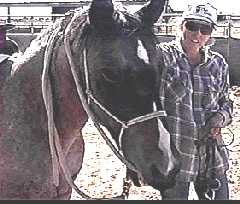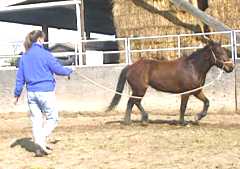|
Longeing is an effective way to put a horse in motion and work out all sorts of
communications and response issues. Its effectiveness is dependant on the
interaction between the horse and handler. Yet how many of us have seen someone take a longe whip into a round pen or with a horse on a line and chase the unfortunate animal while
incessantly cracking the whip. The horse has already responded to the handler's cue
yet he/she continues to make noise and chase the horse in mindless circles. The pressure
is never let off and the horse never learns much except to maintain blind flight.
A Least Resistance approach to the same activity would involve cuing the horse
to move out, leaving the horse alone when he is responding correctly, and spending time
interacting with the horse so that the activity actually improves the horse's behavior.
Most of these results are accomplished by not applying excessive pressure
on the horse, especially when the horse is attempting to respond correctly.
Horse training is never actually "resistance free," but then neither is horse social
behavior. Horses are physical and put pressure on each other when they interact.
We apply pressure through aids, leg contact and our physical presence to interact
with the horse. Any time there is pressure involved, there will naturally be some
"resistance." The idea behind Least Resistance is for the handler to pay attention, "read" the horse, apply only as much pressure as is needed to get results, and release that pressure the instant the horse tries to respond.
|
There is no need to "chase" the horse
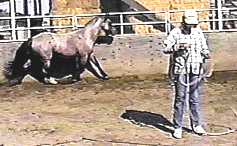
Apply just enough pressure to get results
and release pressure when you get it.
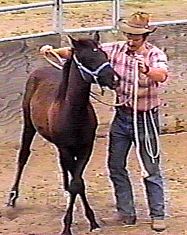
The horse's baseline response you develop on the ground will carry over to your first time in the saddle
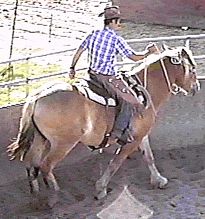
|
|
The training method you use is basically your fuel for developing the horse's
behavior. The less volatile the fuel, the safer and more controlled the
learning process will be.
Least Resistance also involves developing and promoting approaches that entail less restraint and more mental interaction with the horse, relying on curiosity rather than fear. In gentling a wild horse, for example, we would engage the horse and appeal to his learning apparatus to get used to humans rather than snub him to a post and force him to accept our presence or chase him into submission. Horses learn poorly when in an anxious state and in a vast majority of circumstances there is no practical point to putting the animal through any additional stress.
As we start to work with an animal we are imprinting the horse, causing "operant conditioning" to take place. Operant conditioning establishes baseline behavior through which the animal interacts with us. If this baseline is rooted in fear, the horse will be operating primarily in his right brain hemisphere which contains his more reactive self-preservation center. If his baseline is rooted in curiosity, communication and interaction, the horse will be operating primarily in left his brain hemisphere where his thinking and learning centers are located.
All our approaches, whether they be using a pole, squeeze chute, longe line,
obstacles, or anything else, are intended to be presented to the horse so that
he regards them with curiosity rather than fear. We want him to invest his energy in
trying to understand what it is that we are asking from him.
While we do recommend specific tools and approaches, particularly for beginners
who are working with wild horses, it's not so much what tool or approach
we use that counts. It's how we use these things and interact with the horse
that makes the greatest difference.
Curiosity in the horse and good communication between horse and handler provide
the safest fuel for effective training. Some specific examples appear in Part Two.
|
Rather than chase or snub this wild mare to a post,
we start the interaction by "grooming" with a bamboo pole.
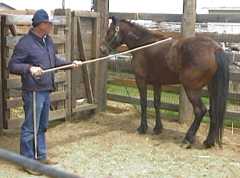
Then the horse isn't spooked by other things we need to do
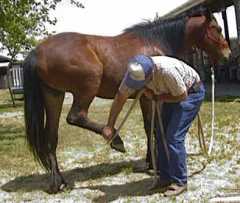
"No fear" produces easy results
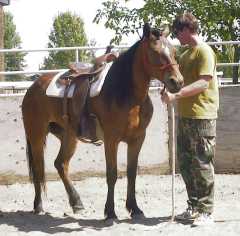
|


